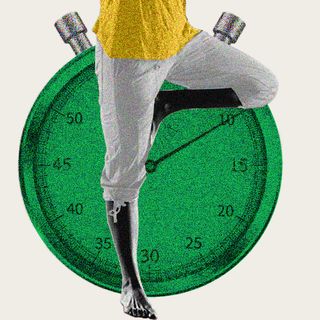
‘Moaning’ Isn’t Really Part of the Female Orgasm, According to Research
Moaning has come to represent the pinnacle of women’s desire and even desirability.

In the canon of literature around pleasure, the female orgasm remains underrepresented and barely acknowledged. What marks a crescendo of pleasure for women is then a collection of guesswork, according to popular culture: How much does an orgasm make the person quiver? Does an orgasm always come with a noisy end? What exactly is the true measure?
There appear to be some new answers. According to a new study, published in The Journal of Sexual Medicine, audiblemoaning should not technically be considered a part of the female orgasm. It is not an accurate measure of pleasure and does little to explain the science and socialization around orgasms. Calling to question the sensory credibility of moaning may also open a can of worms around fake orgasms. In When Harry Met Sally, Meg Ryan rather famously demonstrated how women can fake a sexual climax — linking moaning with orgasms. The way we understand orgasms, then, deserves a more discerning perspective.
Here’s what the current scientific exploration says. Researchers looked at two commonly used sensory and psychological methods in scientific research to understand the position moaning holds. The Orgasm Rating Scale (ORS) includes physical sensations like “trembling”, “quivering,” “building,” and “pulsating”; other markers of emotional intimacy, like “loving” and “passionate” are included too. The Bodily Sensation of Orgasm Scale (BSOS), on the other hand, identifies if the person is breathing faster, is sweating, has an increased heart rate, facial tingling, or even lower limb spasms. Together and apart, they become a way to measure the scale and scope of the female orgasm.
The study included answers from pre-, peri-, and post-menopausal women between the ages of 18 and 82. They were asked to fill out a questionnaire about their orgasm experiences in both solitary and partnered contexts. The researchers found some points checked off from both the scales: the women experienced choppy breath, hot flashes, and increased blood pressure. “Orgasm, particularly in older women, remains a poorly understood aspect of female sexual response partly because of a lack of validated self-report measures,” said lead author, Amy Elizabeth Webb.
Related on The Swaddle:
Orgasming Less Often Can Make Women Give Up Trying, Widening the ‘Orgasm Gap’
These self-documented instances of orgasm tell an important story: on the ORS scale, “pleasurable satisfaction” was the most well-reported sign, but things like emotional intimacy or shooting sensation were uncommon. On the BSOS scale, “extragenital sensations,” “genital sensations,” and “sweating” were quite popular; whereas moaning and anal contractions figured the least.
In other words, when women thought of orgasm, they don’t always moan or yelp loudly. The absence was so significant in the study that the researchers suggest it be discounted from being considered a measure of pleasure itself because it offered little use. The researchers recommended that moaning, or “copulatory vocalization” should ideally be removed from the BSOS.
Copulatory vocalization doesn’t quite fit the orgasm bill because it isn’t an “involuntary” response the body has to pleasure. Whether a partner moans or doesn’t isn’t quite telling of how much, or how little, they enjoy sex. This may defy the thin library of female pleasure movies and shows have built: almost always a sexual climax comes with auditory company.
The purpose and point of noise during sex is a hotly contested research territory. While the current research may deflate moaning as a measure of orgasm, there is still strong evidence to show noise plays a part in revving up desires and helps with sexual intercourse overall. A 2012 study showed that moaning may even be linked to a more satisfying sex life for all partners. So while moaning and pleasure may be interlinked in some shape and rhythm, thinking of it as an indicator of female pleasure may be misguided in part. Pop culture and pornographic representations of sex may have something to do with it, but the jury is still out on why, exactly, moaning came to represent the pinnacle of women’s desire and even desirability.
The semantics of moaning aside, the heart of the current findings beats in the direction of finding outmore about the female orgasm. Any and all knowledge will help to close the “orgasm gap” — the disparity in orgasms between cis-gendered men and women in heterosexual relationships. If women orgasm less, they won’t quite expect and desire orgasm the same way. Before that, we must at least endeavor to piece together the many, many parts that constitute female pleasure.
Saumya Kalia is an Associate Editor at The Swaddle. Her journalism and writing explore issues of social justice, digital sub-cultures, media ecosystem, literature, and memory as they cut across socio-cultural periods. You can reach her at @Saumya_Kalia.
Related


New Research Shows Most People Don’t Want to Be Billionaires
